Customer Value Management Report: Strategies, Analysis, and Case Study
VerifiedAdded on 2020/10/22
|13
|3890
|475
Report
AI Summary
This report provides a comprehensive analysis of Customer Value Management (CVM), focusing on strategies to enhance customer relationships and maximize customer lifetime value (CLV). The report begins with an introduction to CVM and its importance, followed by an in-depth examination of CLV components, including revenue, costs, and customer acquisition. It explores factors influencing CLV, such as product quality, service levels, market stability, and company objectives. The report then delves into marketing segmentation strategies, specifically the STP model (Segmentation, Targeting, Positioning), and how these strategies can be applied to a customer base. Furthermore, it examines the B2B and B2C decision-making models, highlighting opportunities for customer value creation. The report concludes by discussing various techniques and methods organizations use to increase customer relationships and loyalty, offering insights and practical applications for businesses aiming to improve their CVM practices. The report uses the Homebase company as a case study to provide real-world examples and insights.
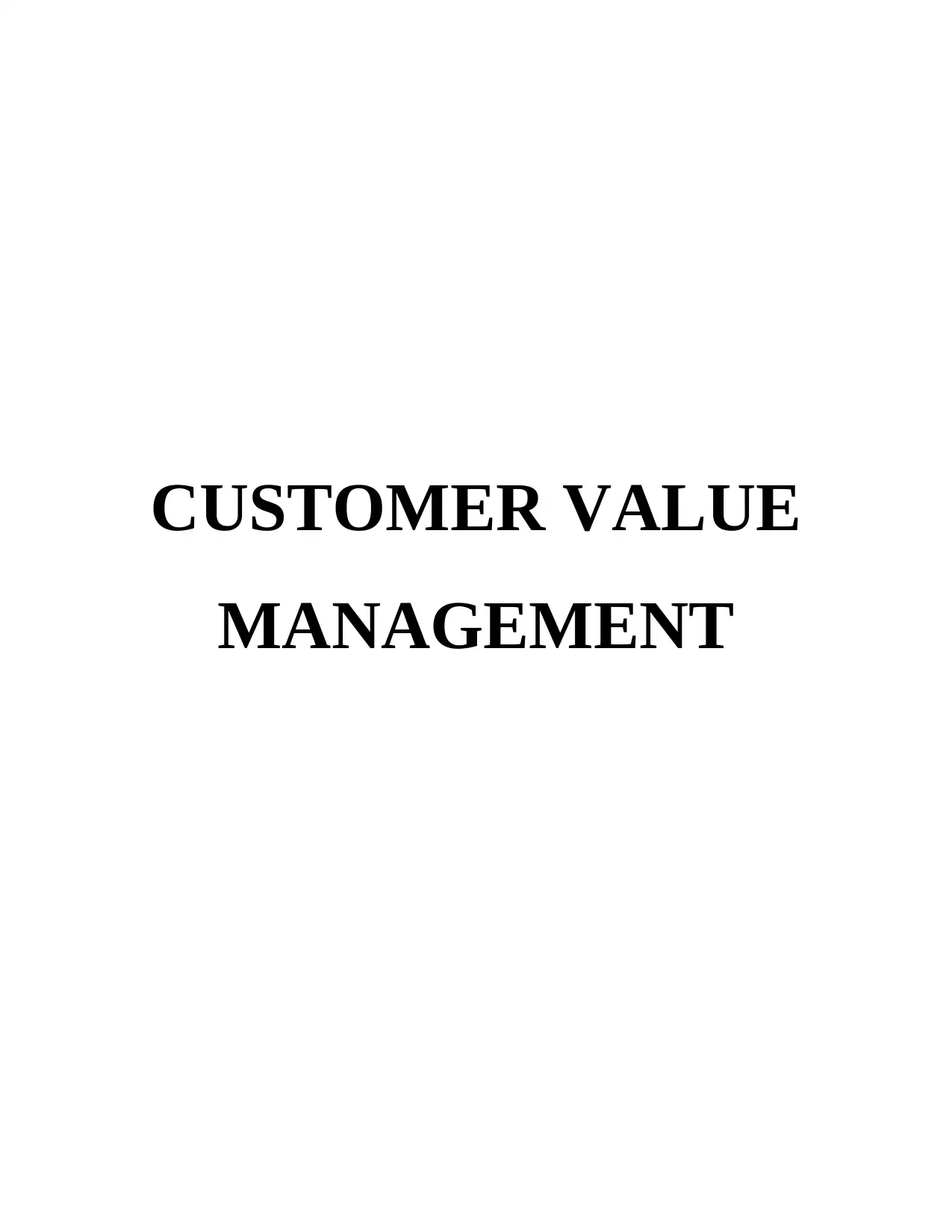
CUSTOMER VALUE
MANAGEMENT
MANAGEMENT
Paraphrase This Document
Need a fresh take? Get an instant paraphrase of this document with our AI Paraphraser
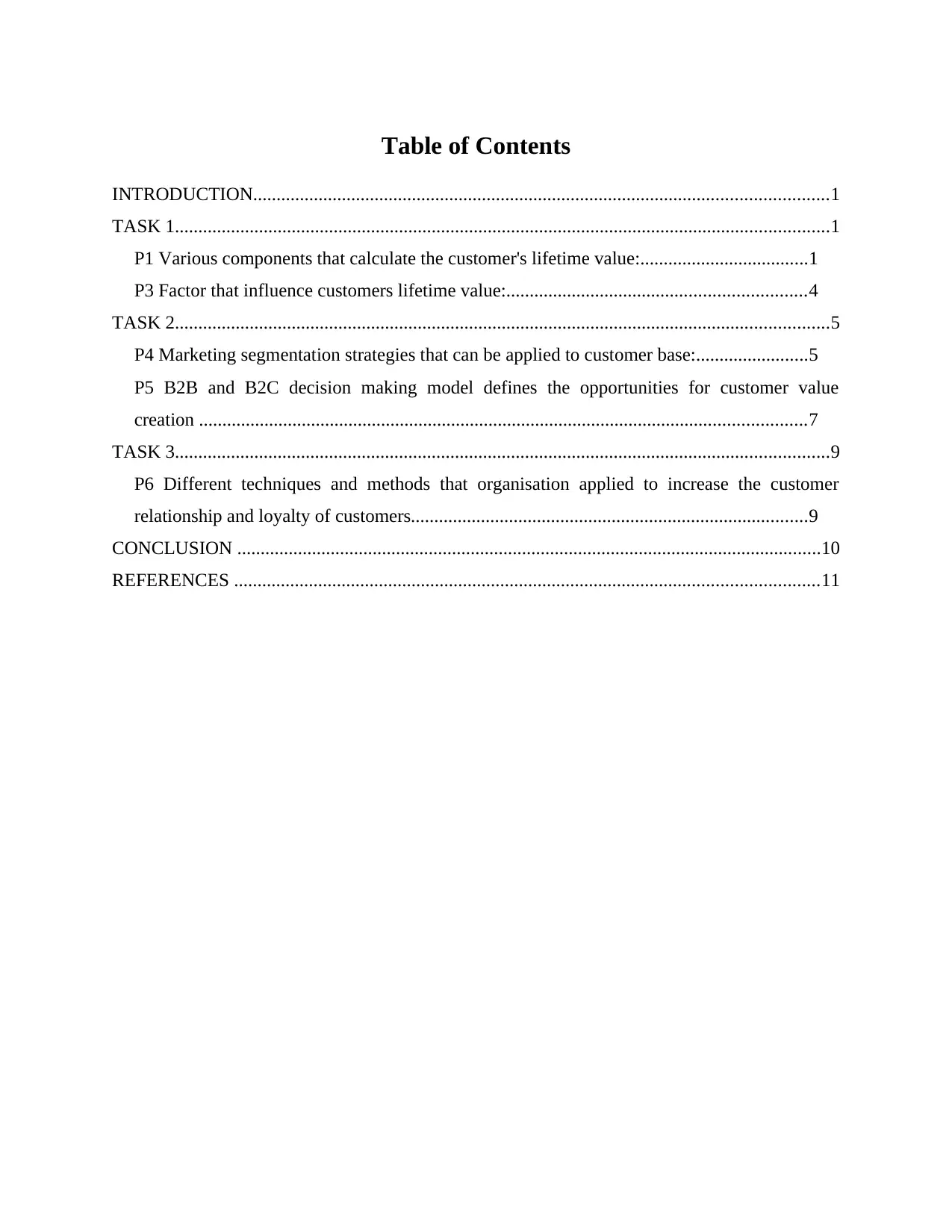
Table of Contents
INTRODUCTION...........................................................................................................................1
TASK 1............................................................................................................................................1
P1 Various components that calculate the customer's lifetime value:....................................1
P3 Factor that influence customers lifetime value:................................................................4
TASK 2............................................................................................................................................5
P4 Marketing segmentation strategies that can be applied to customer base:........................5
P5 B2B and B2C decision making model defines the opportunities for customer value
creation ..................................................................................................................................7
TASK 3............................................................................................................................................9
P6 Different techniques and methods that organisation applied to increase the customer
relationship and loyalty of customers.....................................................................................9
CONCLUSION .............................................................................................................................10
REFERENCES .............................................................................................................................11
INTRODUCTION...........................................................................................................................1
TASK 1............................................................................................................................................1
P1 Various components that calculate the customer's lifetime value:....................................1
P3 Factor that influence customers lifetime value:................................................................4
TASK 2............................................................................................................................................5
P4 Marketing segmentation strategies that can be applied to customer base:........................5
P5 B2B and B2C decision making model defines the opportunities for customer value
creation ..................................................................................................................................7
TASK 3............................................................................................................................................9
P6 Different techniques and methods that organisation applied to increase the customer
relationship and loyalty of customers.....................................................................................9
CONCLUSION .............................................................................................................................10
REFERENCES .............................................................................................................................11
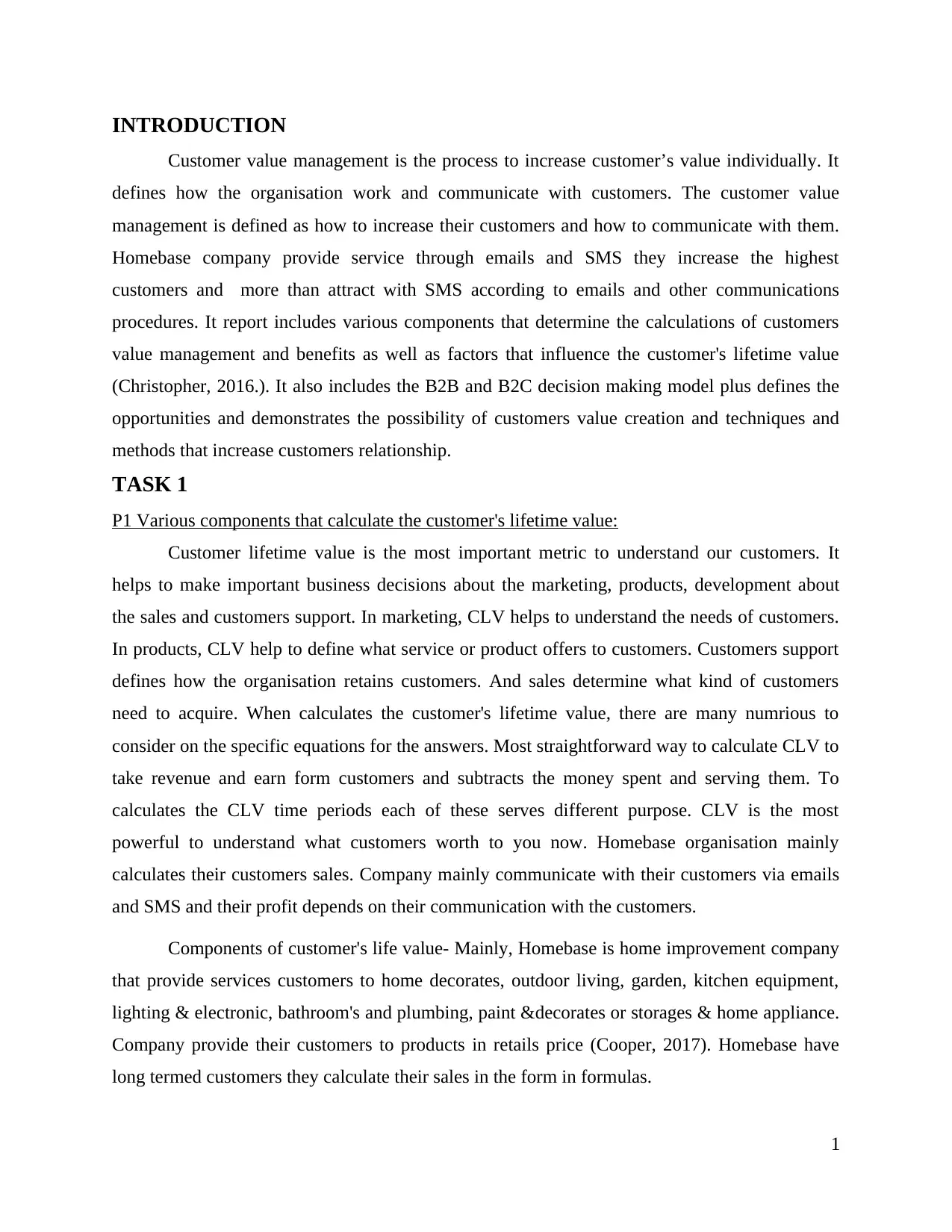
INTRODUCTION
Customer value management is the process to increase customer’s value individually. It
defines how the organisation work and communicate with customers. The customer value
management is defined as how to increase their customers and how to communicate with them.
Homebase company provide service through emails and SMS they increase the highest
customers and more than attract with SMS according to emails and other communications
procedures. It report includes various components that determine the calculations of customers
value management and benefits as well as factors that influence the customer's lifetime value
(Christopher, 2016.). It also includes the B2B and B2C decision making model plus defines the
opportunities and demonstrates the possibility of customers value creation and techniques and
methods that increase customers relationship.
TASK 1
P1 Various components that calculate the customer's lifetime value:
Customer lifetime value is the most important metric to understand our customers. It
helps to make important business decisions about the marketing, products, development about
the sales and customers support. In marketing, CLV helps to understand the needs of customers.
In products, CLV help to define what service or product offers to customers. Customers support
defines how the organisation retains customers. And sales determine what kind of customers
need to acquire. When calculates the customer's lifetime value, there are many numrious to
consider on the specific equations for the answers. Most straightforward way to calculate CLV to
take revenue and earn form customers and subtracts the money spent and serving them. To
calculates the CLV time periods each of these serves different purpose. CLV is the most
powerful to understand what customers worth to you now. Homebase organisation mainly
calculates their customers sales. Company mainly communicate with their customers via emails
and SMS and their profit depends on their communication with the customers.
Components of customer's life value- Mainly, Homebase is home improvement company
that provide services customers to home decorates, outdoor living, garden, kitchen equipment,
lighting & electronic, bathroom's and plumbing, paint &decorates or storages & home appliance.
Company provide their customers to products in retails price (Cooper, 2017). Homebase have
long termed customers they calculate their sales in the form in formulas.
1
Customer value management is the process to increase customer’s value individually. It
defines how the organisation work and communicate with customers. The customer value
management is defined as how to increase their customers and how to communicate with them.
Homebase company provide service through emails and SMS they increase the highest
customers and more than attract with SMS according to emails and other communications
procedures. It report includes various components that determine the calculations of customers
value management and benefits as well as factors that influence the customer's lifetime value
(Christopher, 2016.). It also includes the B2B and B2C decision making model plus defines the
opportunities and demonstrates the possibility of customers value creation and techniques and
methods that increase customers relationship.
TASK 1
P1 Various components that calculate the customer's lifetime value:
Customer lifetime value is the most important metric to understand our customers. It
helps to make important business decisions about the marketing, products, development about
the sales and customers support. In marketing, CLV helps to understand the needs of customers.
In products, CLV help to define what service or product offers to customers. Customers support
defines how the organisation retains customers. And sales determine what kind of customers
need to acquire. When calculates the customer's lifetime value, there are many numrious to
consider on the specific equations for the answers. Most straightforward way to calculate CLV to
take revenue and earn form customers and subtracts the money spent and serving them. To
calculates the CLV time periods each of these serves different purpose. CLV is the most
powerful to understand what customers worth to you now. Homebase organisation mainly
calculates their customers sales. Company mainly communicate with their customers via emails
and SMS and their profit depends on their communication with the customers.
Components of customer's life value- Mainly, Homebase is home improvement company
that provide services customers to home decorates, outdoor living, garden, kitchen equipment,
lighting & electronic, bathroom's and plumbing, paint &decorates or storages & home appliance.
Company provide their customers to products in retails price (Cooper, 2017). Homebase have
long termed customers they calculate their sales in the form in formulas.
1
⊘ This is a preview!⊘
Do you want full access?
Subscribe today to unlock all pages.

Trusted by 1+ million students worldwide
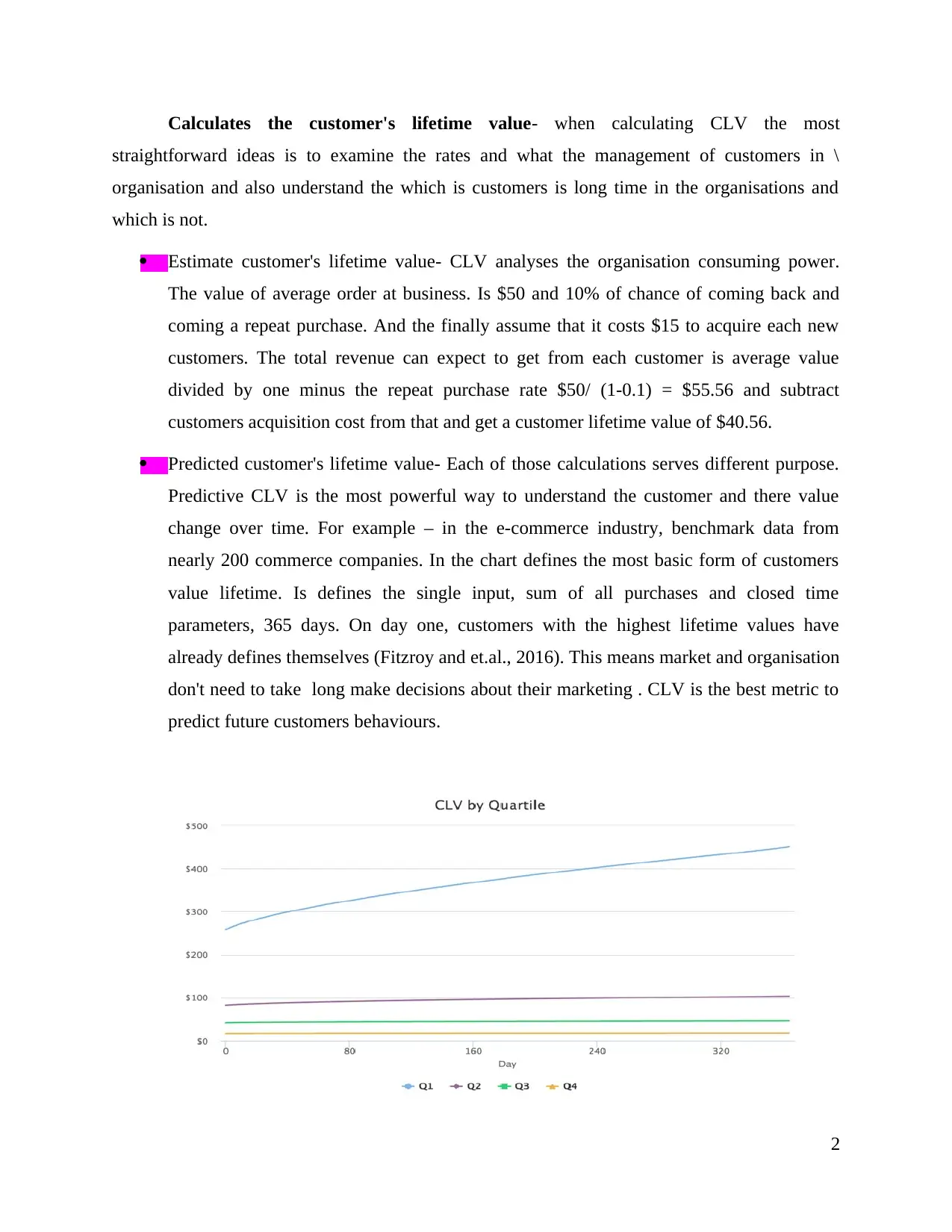
Calculates the customer's lifetime value- when calculating CLV the most
straightforward ideas is to examine the rates and what the management of customers in \
organisation and also understand the which is customers is long time in the organisations and
which is not.
Estimate customer's lifetime value- CLV analyses the organisation consuming power.
The value of average order at business. Is $50 and 10% of chance of coming back and
coming a repeat purchase. And the finally assume that it costs $15 to acquire each new
customers. The total revenue can expect to get from each customer is average value
divided by one minus the repeat purchase rate $50/ (1-0.1) = $55.56 and subtract
customers acquisition cost from that and get a customer lifetime value of $40.56.
Predicted customer's lifetime value- Each of those calculations serves different purpose.
Predictive CLV is the most powerful way to understand the customer and there value
change over time. For example – in the e-commerce industry, benchmark data from
nearly 200 commerce companies. In the chart defines the most basic form of customers
value lifetime. Is defines the single input, sum of all purchases and closed time
parameters, 365 days. On day one, customers with the highest lifetime values have
already defines themselves (Fitzroy and et.al., 2016). This means market and organisation
don't need to take long make decisions about their marketing . CLV is the best metric to
predict future customers behaviours.
2
straightforward ideas is to examine the rates and what the management of customers in \
organisation and also understand the which is customers is long time in the organisations and
which is not.
Estimate customer's lifetime value- CLV analyses the organisation consuming power.
The value of average order at business. Is $50 and 10% of chance of coming back and
coming a repeat purchase. And the finally assume that it costs $15 to acquire each new
customers. The total revenue can expect to get from each customer is average value
divided by one minus the repeat purchase rate $50/ (1-0.1) = $55.56 and subtract
customers acquisition cost from that and get a customer lifetime value of $40.56.
Predicted customer's lifetime value- Each of those calculations serves different purpose.
Predictive CLV is the most powerful way to understand the customer and there value
change over time. For example – in the e-commerce industry, benchmark data from
nearly 200 commerce companies. In the chart defines the most basic form of customers
value lifetime. Is defines the single input, sum of all purchases and closed time
parameters, 365 days. On day one, customers with the highest lifetime values have
already defines themselves (Fitzroy and et.al., 2016). This means market and organisation
don't need to take long make decisions about their marketing . CLV is the best metric to
predict future customers behaviours.
2
Paraphrase This Document
Need a fresh take? Get an instant paraphrase of this document with our AI Paraphraser
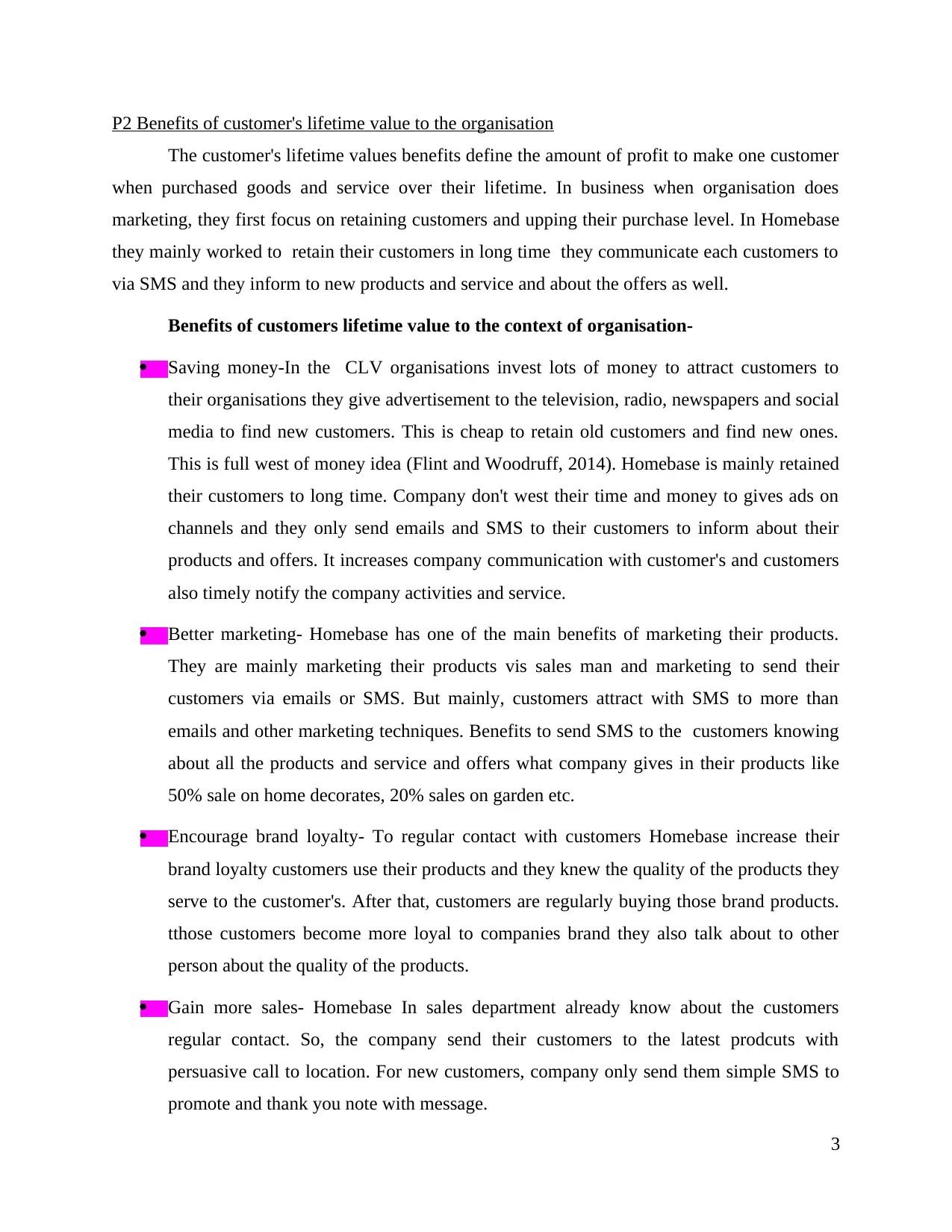
P2 Benefits of customer's lifetime value to the organisation
The customer's lifetime values benefits define the amount of profit to make one customer
when purchased goods and service over their lifetime. In business when organisation does
marketing, they first focus on retaining customers and upping their purchase level. In Homebase
they mainly worked to retain their customers in long time they communicate each customers to
via SMS and they inform to new products and service and about the offers as well.
Benefits of customers lifetime value to the context of organisation-
Saving money-In the CLV organisations invest lots of money to attract customers to
their organisations they give advertisement to the television, radio, newspapers and social
media to find new customers. This is cheap to retain old customers and find new ones.
This is full west of money idea (Flint and Woodruff, 2014). Homebase is mainly retained
their customers to long time. Company don't west their time and money to gives ads on
channels and they only send emails and SMS to their customers to inform about their
products and offers. It increases company communication with customer's and customers
also timely notify the company activities and service.
Better marketing- Homebase has one of the main benefits of marketing their products.
They are mainly marketing their products vis sales man and marketing to send their
customers via emails or SMS. But mainly, customers attract with SMS to more than
emails and other marketing techniques. Benefits to send SMS to the customers knowing
about all the products and service and offers what company gives in their products like
50% sale on home decorates, 20% sales on garden etc.
Encourage brand loyalty- To regular contact with customers Homebase increase their
brand loyalty customers use their products and they knew the quality of the products they
serve to the customer's. After that, customers are regularly buying those brand products.
tthose customers become more loyal to companies brand they also talk about to other
person about the quality of the products.
Gain more sales- Homebase In sales department already know about the customers
regular contact. So, the company send their customers to the latest prodcuts with
persuasive call to location. For new customers, company only send them simple SMS to
promote and thank you note with message.
3
The customer's lifetime values benefits define the amount of profit to make one customer
when purchased goods and service over their lifetime. In business when organisation does
marketing, they first focus on retaining customers and upping their purchase level. In Homebase
they mainly worked to retain their customers in long time they communicate each customers to
via SMS and they inform to new products and service and about the offers as well.
Benefits of customers lifetime value to the context of organisation-
Saving money-In the CLV organisations invest lots of money to attract customers to
their organisations they give advertisement to the television, radio, newspapers and social
media to find new customers. This is cheap to retain old customers and find new ones.
This is full west of money idea (Flint and Woodruff, 2014). Homebase is mainly retained
their customers to long time. Company don't west their time and money to gives ads on
channels and they only send emails and SMS to their customers to inform about their
products and offers. It increases company communication with customer's and customers
also timely notify the company activities and service.
Better marketing- Homebase has one of the main benefits of marketing their products.
They are mainly marketing their products vis sales man and marketing to send their
customers via emails or SMS. But mainly, customers attract with SMS to more than
emails and other marketing techniques. Benefits to send SMS to the customers knowing
about all the products and service and offers what company gives in their products like
50% sale on home decorates, 20% sales on garden etc.
Encourage brand loyalty- To regular contact with customers Homebase increase their
brand loyalty customers use their products and they knew the quality of the products they
serve to the customer's. After that, customers are regularly buying those brand products.
tthose customers become more loyal to companies brand they also talk about to other
person about the quality of the products.
Gain more sales- Homebase In sales department already know about the customers
regular contact. So, the company send their customers to the latest prodcuts with
persuasive call to location. For new customers, company only send them simple SMS to
promote and thank you note with message.
3
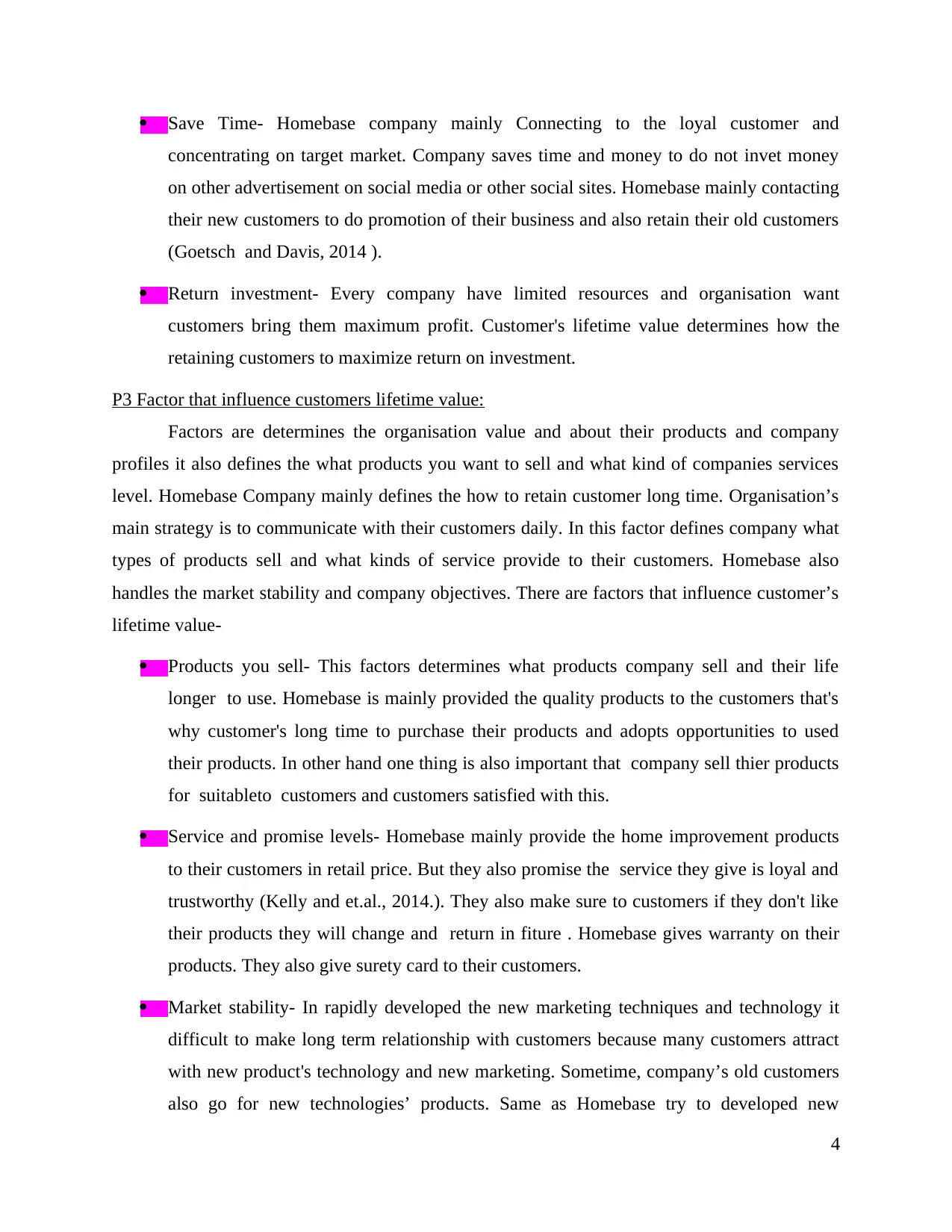
Save Time- Homebase company mainly Connecting to the loyal customer and
concentrating on target market. Company saves time and money to do not invet money
on other advertisement on social media or other social sites. Homebase mainly contacting
their new customers to do promotion of their business and also retain their old customers
(Goetsch and Davis, 2014 ).
Return investment- Every company have limited resources and organisation want
customers bring them maximum profit. Customer's lifetime value determines how the
retaining customers to maximize return on investment.
P3 Factor that influence customers lifetime value:
Factors are determines the organisation value and about their products and company
profiles it also defines the what products you want to sell and what kind of companies services
level. Homebase Company mainly defines the how to retain customer long time. Organisation’s
main strategy is to communicate with their customers daily. In this factor defines company what
types of products sell and what kinds of service provide to their customers. Homebase also
handles the market stability and company objectives. There are factors that influence customer’s
lifetime value-
Products you sell- This factors determines what products company sell and their life
longer to use. Homebase is mainly provided the quality products to the customers that's
why customer's long time to purchase their products and adopts opportunities to used
their products. In other hand one thing is also important that company sell thier products
for suitableto customers and customers satisfied with this.
Service and promise levels- Homebase mainly provide the home improvement products
to their customers in retail price. But they also promise the service they give is loyal and
trustworthy (Kelly and et.al., 2014.). They also make sure to customers if they don't like
their products they will change and return in fiture . Homebase gives warranty on their
products. They also give surety card to their customers.
Market stability- In rapidly developed the new marketing techniques and technology it
difficult to make long term relationship with customers because many customers attract
with new product's technology and new marketing. Sometime, company’s old customers
also go for new technologies’ products. Same as Homebase try to developed new
4
concentrating on target market. Company saves time and money to do not invet money
on other advertisement on social media or other social sites. Homebase mainly contacting
their new customers to do promotion of their business and also retain their old customers
(Goetsch and Davis, 2014 ).
Return investment- Every company have limited resources and organisation want
customers bring them maximum profit. Customer's lifetime value determines how the
retaining customers to maximize return on investment.
P3 Factor that influence customers lifetime value:
Factors are determines the organisation value and about their products and company
profiles it also defines the what products you want to sell and what kind of companies services
level. Homebase Company mainly defines the how to retain customer long time. Organisation’s
main strategy is to communicate with their customers daily. In this factor defines company what
types of products sell and what kinds of service provide to their customers. Homebase also
handles the market stability and company objectives. There are factors that influence customer’s
lifetime value-
Products you sell- This factors determines what products company sell and their life
longer to use. Homebase is mainly provided the quality products to the customers that's
why customer's long time to purchase their products and adopts opportunities to used
their products. In other hand one thing is also important that company sell thier products
for suitableto customers and customers satisfied with this.
Service and promise levels- Homebase mainly provide the home improvement products
to their customers in retail price. But they also promise the service they give is loyal and
trustworthy (Kelly and et.al., 2014.). They also make sure to customers if they don't like
their products they will change and return in fiture . Homebase gives warranty on their
products. They also give surety card to their customers.
Market stability- In rapidly developed the new marketing techniques and technology it
difficult to make long term relationship with customers because many customers attract
with new product's technology and new marketing. Sometime, company’s old customers
also go for new technologies’ products. Same as Homebase try to developed new
4
⊘ This is a preview!⊘
Do you want full access?
Subscribe today to unlock all pages.

Trusted by 1+ million students worldwide
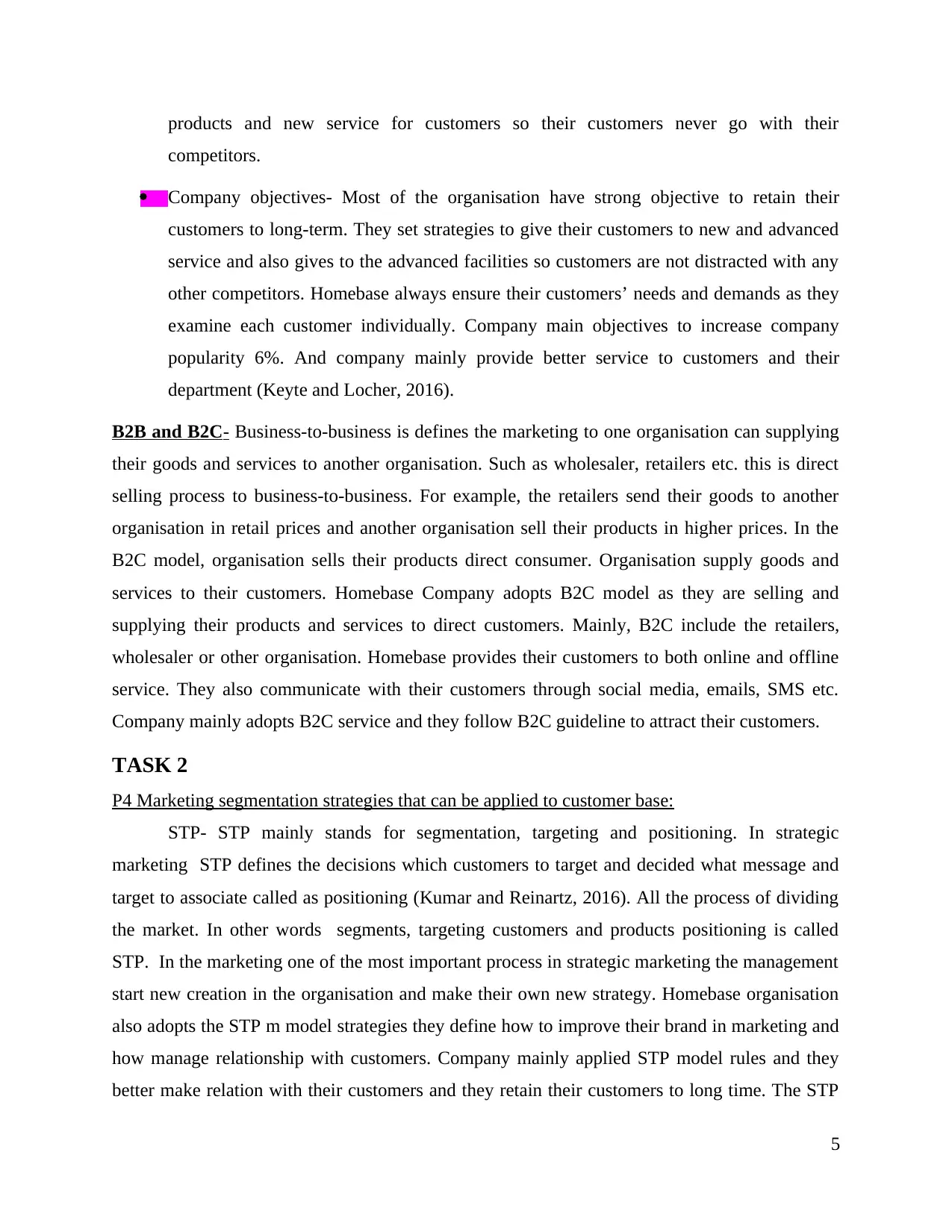
products and new service for customers so their customers never go with their
competitors.
Company objectives- Most of the organisation have strong objective to retain their
customers to long-term. They set strategies to give their customers to new and advanced
service and also gives to the advanced facilities so customers are not distracted with any
other competitors. Homebase always ensure their customers’ needs and demands as they
examine each customer individually. Company main objectives to increase company
popularity 6%. And company mainly provide better service to customers and their
department (Keyte and Locher, 2016).
B2B and B2C- Business-to-business is defines the marketing to one organisation can supplying
their goods and services to another organisation. Such as wholesaler, retailers etc. this is direct
selling process to business-to-business. For example, the retailers send their goods to another
organisation in retail prices and another organisation sell their products in higher prices. In the
B2C model, organisation sells their products direct consumer. Organisation supply goods and
services to their customers. Homebase Company adopts B2C model as they are selling and
supplying their products and services to direct customers. Mainly, B2C include the retailers,
wholesaler or other organisation. Homebase provides their customers to both online and offline
service. They also communicate with their customers through social media, emails, SMS etc.
Company mainly adopts B2C service and they follow B2C guideline to attract their customers.
TASK 2
P4 Marketing segmentation strategies that can be applied to customer base:
STP- STP mainly stands for segmentation, targeting and positioning. In strategic
marketing STP defines the decisions which customers to target and decided what message and
target to associate called as positioning (Kumar and Reinartz, 2016). All the process of dividing
the market. In other words segments, targeting customers and products positioning is called
STP. In the marketing one of the most important process in strategic marketing the management
start new creation in the organisation and make their own new strategy. Homebase organisation
also adopts the STP m model strategies they define how to improve their brand in marketing and
how manage relationship with customers. Company mainly applied STP model rules and they
better make relation with their customers and they retain their customers to long time. The STP
5
competitors.
Company objectives- Most of the organisation have strong objective to retain their
customers to long-term. They set strategies to give their customers to new and advanced
service and also gives to the advanced facilities so customers are not distracted with any
other competitors. Homebase always ensure their customers’ needs and demands as they
examine each customer individually. Company main objectives to increase company
popularity 6%. And company mainly provide better service to customers and their
department (Keyte and Locher, 2016).
B2B and B2C- Business-to-business is defines the marketing to one organisation can supplying
their goods and services to another organisation. Such as wholesaler, retailers etc. this is direct
selling process to business-to-business. For example, the retailers send their goods to another
organisation in retail prices and another organisation sell their products in higher prices. In the
B2C model, organisation sells their products direct consumer. Organisation supply goods and
services to their customers. Homebase Company adopts B2C model as they are selling and
supplying their products and services to direct customers. Mainly, B2C include the retailers,
wholesaler or other organisation. Homebase provides their customers to both online and offline
service. They also communicate with their customers through social media, emails, SMS etc.
Company mainly adopts B2C service and they follow B2C guideline to attract their customers.
TASK 2
P4 Marketing segmentation strategies that can be applied to customer base:
STP- STP mainly stands for segmentation, targeting and positioning. In strategic
marketing STP defines the decisions which customers to target and decided what message and
target to associate called as positioning (Kumar and Reinartz, 2016). All the process of dividing
the market. In other words segments, targeting customers and products positioning is called
STP. In the marketing one of the most important process in strategic marketing the management
start new creation in the organisation and make their own new strategy. Homebase organisation
also adopts the STP m model strategies they define how to improve their brand in marketing and
how manage relationship with customers. Company mainly applied STP model rules and they
better make relation with their customers and they retain their customers to long time. The STP
5
Paraphrase This Document
Need a fresh take? Get an instant paraphrase of this document with our AI Paraphraser
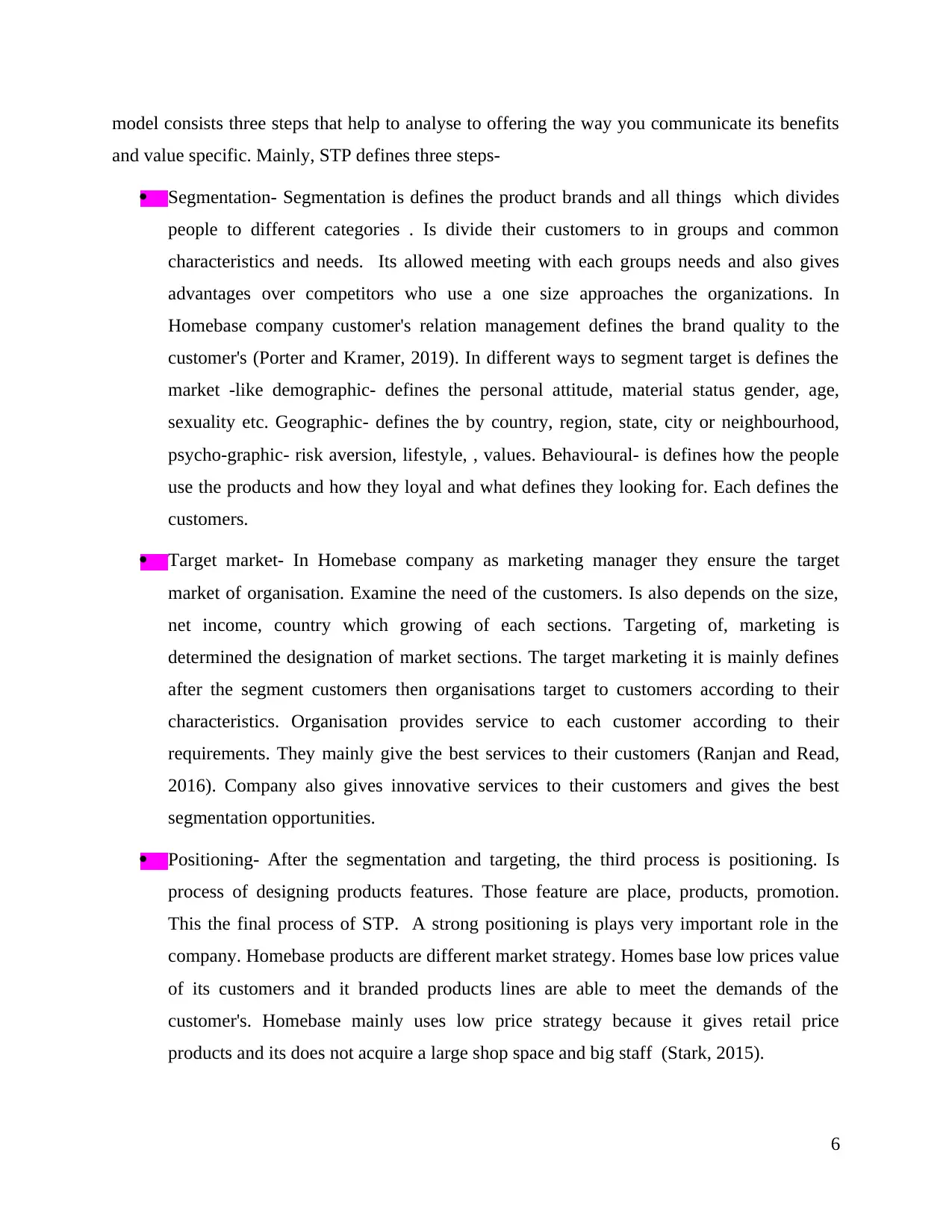
model consists three steps that help to analyse to offering the way you communicate its benefits
and value specific. Mainly, STP defines three steps-
Segmentation- Segmentation is defines the product brands and all things which divides
people to different categories . Is divide their customers to in groups and common
characteristics and needs. Its allowed meeting with each groups needs and also gives
advantages over competitors who use a one size approaches the organizations. In
Homebase company customer's relation management defines the brand quality to the
customer's (Porter and Kramer, 2019). In different ways to segment target is defines the
market -like demographic- defines the personal attitude, material status gender, age,
sexuality etc. Geographic- defines the by country, region, state, city or neighbourhood,
psycho-graphic- risk aversion, lifestyle, , values. Behavioural- is defines how the people
use the products and how they loyal and what defines they looking for. Each defines the
customers.
Target market- In Homebase company as marketing manager they ensure the target
market of organisation. Examine the need of the customers. Is also depends on the size,
net income, country which growing of each sections. Targeting of, marketing is
determined the designation of market sections. The target marketing it is mainly defines
after the segment customers then organisations target to customers according to their
characteristics. Organisation provides service to each customer according to their
requirements. They mainly give the best services to their customers (Ranjan and Read,
2016). Company also gives innovative services to their customers and gives the best
segmentation opportunities.
Positioning- After the segmentation and targeting, the third process is positioning. Is
process of designing products features. Those feature are place, products, promotion.
This the final process of STP. A strong positioning is plays very important role in the
company. Homebase products are different market strategy. Homes base low prices value
of its customers and it branded products lines are able to meet the demands of the
customer's. Homebase mainly uses low price strategy because it gives retail price
products and its does not acquire a large shop space and big staff (Stark, 2015).
6
and value specific. Mainly, STP defines three steps-
Segmentation- Segmentation is defines the product brands and all things which divides
people to different categories . Is divide their customers to in groups and common
characteristics and needs. Its allowed meeting with each groups needs and also gives
advantages over competitors who use a one size approaches the organizations. In
Homebase company customer's relation management defines the brand quality to the
customer's (Porter and Kramer, 2019). In different ways to segment target is defines the
market -like demographic- defines the personal attitude, material status gender, age,
sexuality etc. Geographic- defines the by country, region, state, city or neighbourhood,
psycho-graphic- risk aversion, lifestyle, , values. Behavioural- is defines how the people
use the products and how they loyal and what defines they looking for. Each defines the
customers.
Target market- In Homebase company as marketing manager they ensure the target
market of organisation. Examine the need of the customers. Is also depends on the size,
net income, country which growing of each sections. Targeting of, marketing is
determined the designation of market sections. The target marketing it is mainly defines
after the segment customers then organisations target to customers according to their
characteristics. Organisation provides service to each customer according to their
requirements. They mainly give the best services to their customers (Ranjan and Read,
2016). Company also gives innovative services to their customers and gives the best
segmentation opportunities.
Positioning- After the segmentation and targeting, the third process is positioning. Is
process of designing products features. Those feature are place, products, promotion.
This the final process of STP. A strong positioning is plays very important role in the
company. Homebase products are different market strategy. Homes base low prices value
of its customers and it branded products lines are able to meet the demands of the
customer's. Homebase mainly uses low price strategy because it gives retail price
products and its does not acquire a large shop space and big staff (Stark, 2015).
6
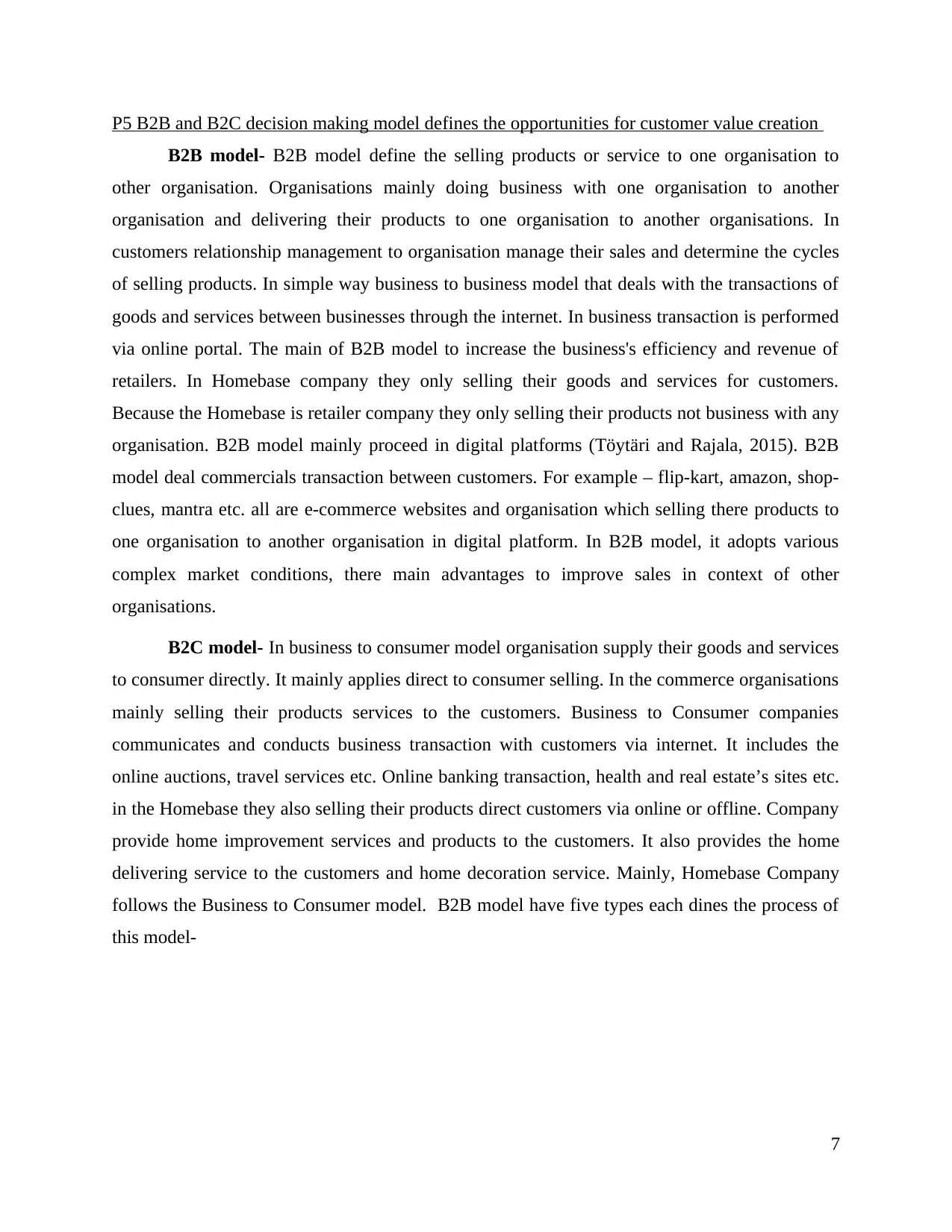
P5 B2B and B2C decision making model defines the opportunities for customer value creation
B2B model- B2B model define the selling products or service to one organisation to
other organisation. Organisations mainly doing business with one organisation to another
organisation and delivering their products to one organisation to another organisations. In
customers relationship management to organisation manage their sales and determine the cycles
of selling products. In simple way business to business model that deals with the transactions of
goods and services between businesses through the internet. In business transaction is performed
via online portal. The main of B2B model to increase the business's efficiency and revenue of
retailers. In Homebase company they only selling their goods and services for customers.
Because the Homebase is retailer company they only selling their products not business with any
organisation. B2B model mainly proceed in digital platforms (Töytäri and Rajala, 2015). B2B
model deal commercials transaction between customers. For example – flip-kart, amazon, shop-
clues, mantra etc. all are e-commerce websites and organisation which selling there products to
one organisation to another organisation in digital platform. In B2B model, it adopts various
complex market conditions, there main advantages to improve sales in context of other
organisations.
B2C model- In business to consumer model organisation supply their goods and services
to consumer directly. It mainly applies direct to consumer selling. In the commerce organisations
mainly selling their products services to the customers. Business to Consumer companies
communicates and conducts business transaction with customers via internet. It includes the
online auctions, travel services etc. Online banking transaction, health and real estate’s sites etc.
in the Homebase they also selling their products direct customers via online or offline. Company
provide home improvement services and products to the customers. It also provides the home
delivering service to the customers and home decoration service. Mainly, Homebase Company
follows the Business to Consumer model. B2B model have five types each dines the process of
this model-
7
B2B model- B2B model define the selling products or service to one organisation to
other organisation. Organisations mainly doing business with one organisation to another
organisation and delivering their products to one organisation to another organisations. In
customers relationship management to organisation manage their sales and determine the cycles
of selling products. In simple way business to business model that deals with the transactions of
goods and services between businesses through the internet. In business transaction is performed
via online portal. The main of B2B model to increase the business's efficiency and revenue of
retailers. In Homebase company they only selling their goods and services for customers.
Because the Homebase is retailer company they only selling their products not business with any
organisation. B2B model mainly proceed in digital platforms (Töytäri and Rajala, 2015). B2B
model deal commercials transaction between customers. For example – flip-kart, amazon, shop-
clues, mantra etc. all are e-commerce websites and organisation which selling there products to
one organisation to another organisation in digital platform. In B2B model, it adopts various
complex market conditions, there main advantages to improve sales in context of other
organisations.
B2C model- In business to consumer model organisation supply their goods and services
to consumer directly. It mainly applies direct to consumer selling. In the commerce organisations
mainly selling their products services to the customers. Business to Consumer companies
communicates and conducts business transaction with customers via internet. It includes the
online auctions, travel services etc. Online banking transaction, health and real estate’s sites etc.
in the Homebase they also selling their products direct customers via online or offline. Company
provide home improvement services and products to the customers. It also provides the home
delivering service to the customers and home decoration service. Mainly, Homebase Company
follows the Business to Consumer model. B2B model have five types each dines the process of
this model-
7
⊘ This is a preview!⊘
Do you want full access?
Subscribe today to unlock all pages.

Trusted by 1+ million students worldwide
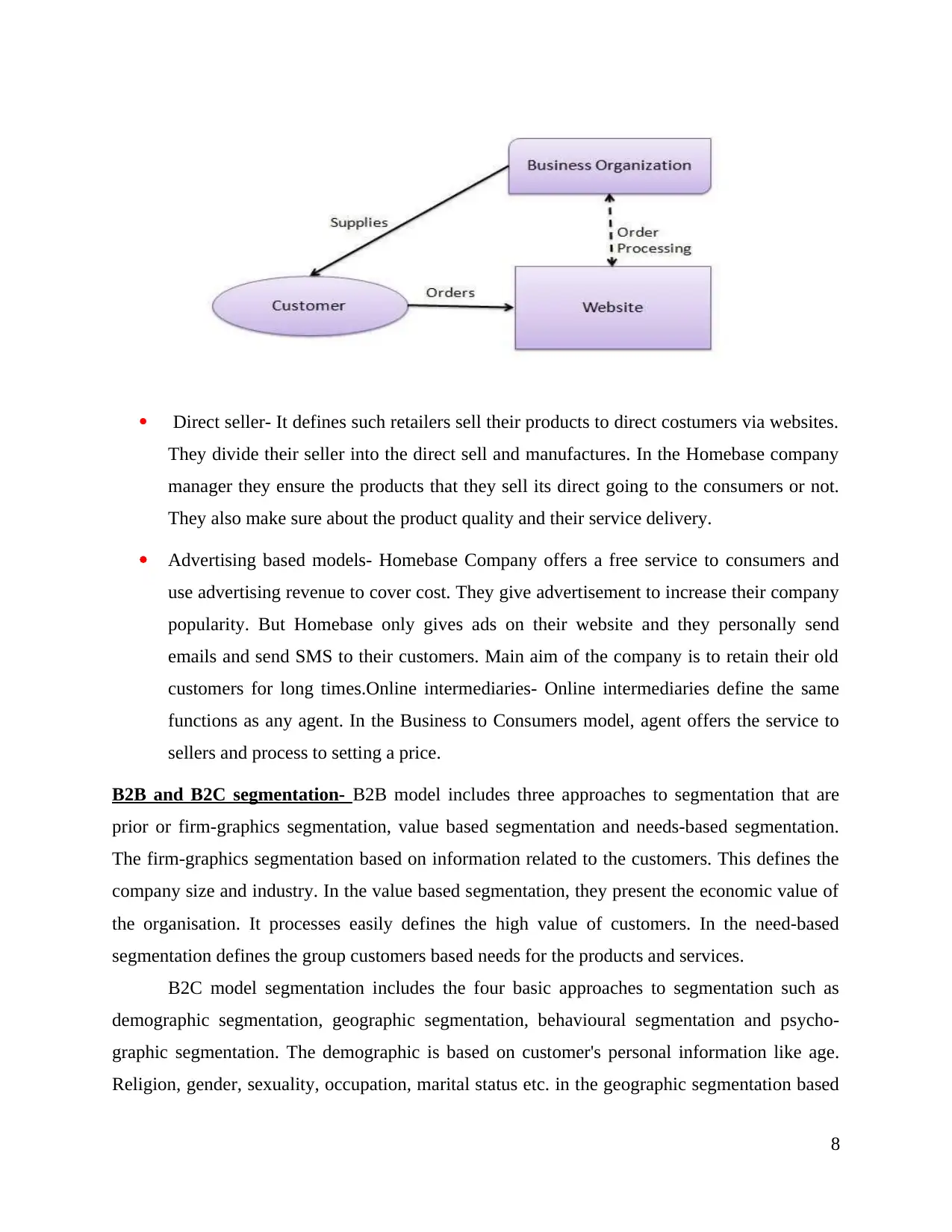
Direct seller- It defines such retailers sell their products to direct costumers via websites.
They divide their seller into the direct sell and manufactures. In the Homebase company
manager they ensure the products that they sell its direct going to the consumers or not.
They also make sure about the product quality and their service delivery.
Advertising based models- Homebase Company offers a free service to consumers and
use advertising revenue to cover cost. They give advertisement to increase their company
popularity. But Homebase only gives ads on their website and they personally send
emails and send SMS to their customers. Main aim of the company is to retain their old
customers for long times.Online intermediaries- Online intermediaries define the same
functions as any agent. In the Business to Consumers model, agent offers the service to
sellers and process to setting a price.
B2B and B2C segmentation- B2B model includes three approaches to segmentation that are
prior or firm-graphics segmentation, value based segmentation and needs-based segmentation.
The firm-graphics segmentation based on information related to the customers. This defines the
company size and industry. In the value based segmentation, they present the economic value of
the organisation. It processes easily defines the high value of customers. In the need-based
segmentation defines the group customers based needs for the products and services.
B2C model segmentation includes the four basic approaches to segmentation such as
demographic segmentation, geographic segmentation, behavioural segmentation and psycho-
graphic segmentation. The demographic is based on customer's personal information like age.
Religion, gender, sexuality, occupation, marital status etc. in the geographic segmentation based
8
They divide their seller into the direct sell and manufactures. In the Homebase company
manager they ensure the products that they sell its direct going to the consumers or not.
They also make sure about the product quality and their service delivery.
Advertising based models- Homebase Company offers a free service to consumers and
use advertising revenue to cover cost. They give advertisement to increase their company
popularity. But Homebase only gives ads on their website and they personally send
emails and send SMS to their customers. Main aim of the company is to retain their old
customers for long times.Online intermediaries- Online intermediaries define the same
functions as any agent. In the Business to Consumers model, agent offers the service to
sellers and process to setting a price.
B2B and B2C segmentation- B2B model includes three approaches to segmentation that are
prior or firm-graphics segmentation, value based segmentation and needs-based segmentation.
The firm-graphics segmentation based on information related to the customers. This defines the
company size and industry. In the value based segmentation, they present the economic value of
the organisation. It processes easily defines the high value of customers. In the need-based
segmentation defines the group customers based needs for the products and services.
B2C model segmentation includes the four basic approaches to segmentation such as
demographic segmentation, geographic segmentation, behavioural segmentation and psycho-
graphic segmentation. The demographic is based on customer's personal information like age.
Religion, gender, sexuality, occupation, marital status etc. in the geographic segmentation based
8
Paraphrase This Document
Need a fresh take? Get an instant paraphrase of this document with our AI Paraphraser
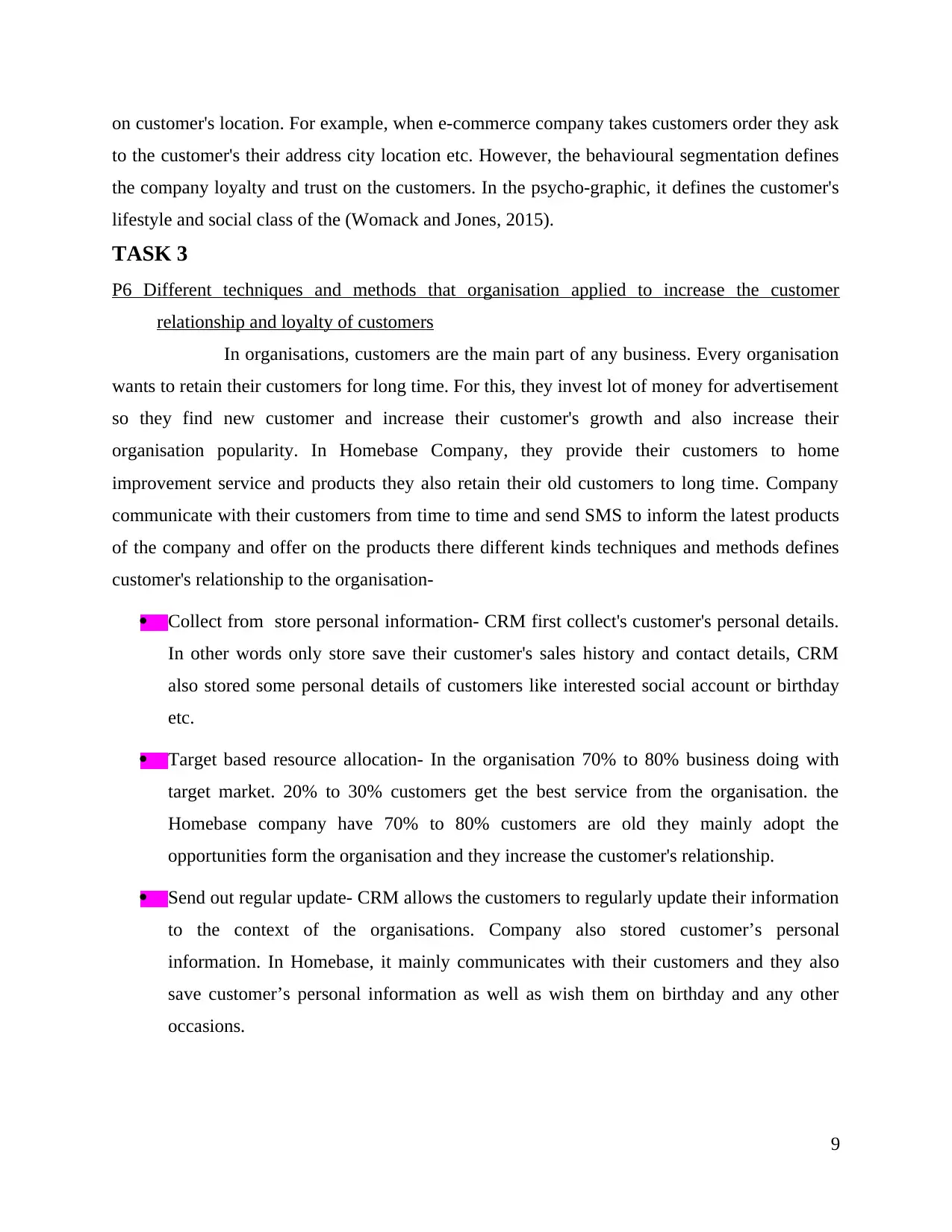
on customer's location. For example, when e-commerce company takes customers order they ask
to the customer's their address city location etc. However, the behavioural segmentation defines
the company loyalty and trust on the customers. In the psycho-graphic, it defines the customer's
lifestyle and social class of the (Womack and Jones, 2015).
TASK 3
P6 Different techniques and methods that organisation applied to increase the customer
relationship and loyalty of customers
In organisations, customers are the main part of any business. Every organisation
wants to retain their customers for long time. For this, they invest lot of money for advertisement
so they find new customer and increase their customer's growth and also increase their
organisation popularity. In Homebase Company, they provide their customers to home
improvement service and products they also retain their old customers to long time. Company
communicate with their customers from time to time and send SMS to inform the latest products
of the company and offer on the products there different kinds techniques and methods defines
customer's relationship to the organisation-
Collect from store personal information- CRM first collect's customer's personal details.
In other words only store save their customer's sales history and contact details, CRM
also stored some personal details of customers like interested social account or birthday
etc.
Target based resource allocation- In the organisation 70% to 80% business doing with
target market. 20% to 30% customers get the best service from the organisation. the
Homebase company have 70% to 80% customers are old they mainly adopt the
opportunities form the organisation and they increase the customer's relationship.
Send out regular update- CRM allows the customers to regularly update their information
to the context of the organisations. Company also stored customer’s personal
information. In Homebase, it mainly communicates with their customers and they also
save customer’s personal information as well as wish them on birthday and any other
occasions.
9
to the customer's their address city location etc. However, the behavioural segmentation defines
the company loyalty and trust on the customers. In the psycho-graphic, it defines the customer's
lifestyle and social class of the (Womack and Jones, 2015).
TASK 3
P6 Different techniques and methods that organisation applied to increase the customer
relationship and loyalty of customers
In organisations, customers are the main part of any business. Every organisation
wants to retain their customers for long time. For this, they invest lot of money for advertisement
so they find new customer and increase their customer's growth and also increase their
organisation popularity. In Homebase Company, they provide their customers to home
improvement service and products they also retain their old customers to long time. Company
communicate with their customers from time to time and send SMS to inform the latest products
of the company and offer on the products there different kinds techniques and methods defines
customer's relationship to the organisation-
Collect from store personal information- CRM first collect's customer's personal details.
In other words only store save their customer's sales history and contact details, CRM
also stored some personal details of customers like interested social account or birthday
etc.
Target based resource allocation- In the organisation 70% to 80% business doing with
target market. 20% to 30% customers get the best service from the organisation. the
Homebase company have 70% to 80% customers are old they mainly adopt the
opportunities form the organisation and they increase the customer's relationship.
Send out regular update- CRM allows the customers to regularly update their information
to the context of the organisations. Company also stored customer’s personal
information. In Homebase, it mainly communicates with their customers and they also
save customer’s personal information as well as wish them on birthday and any other
occasions.
9
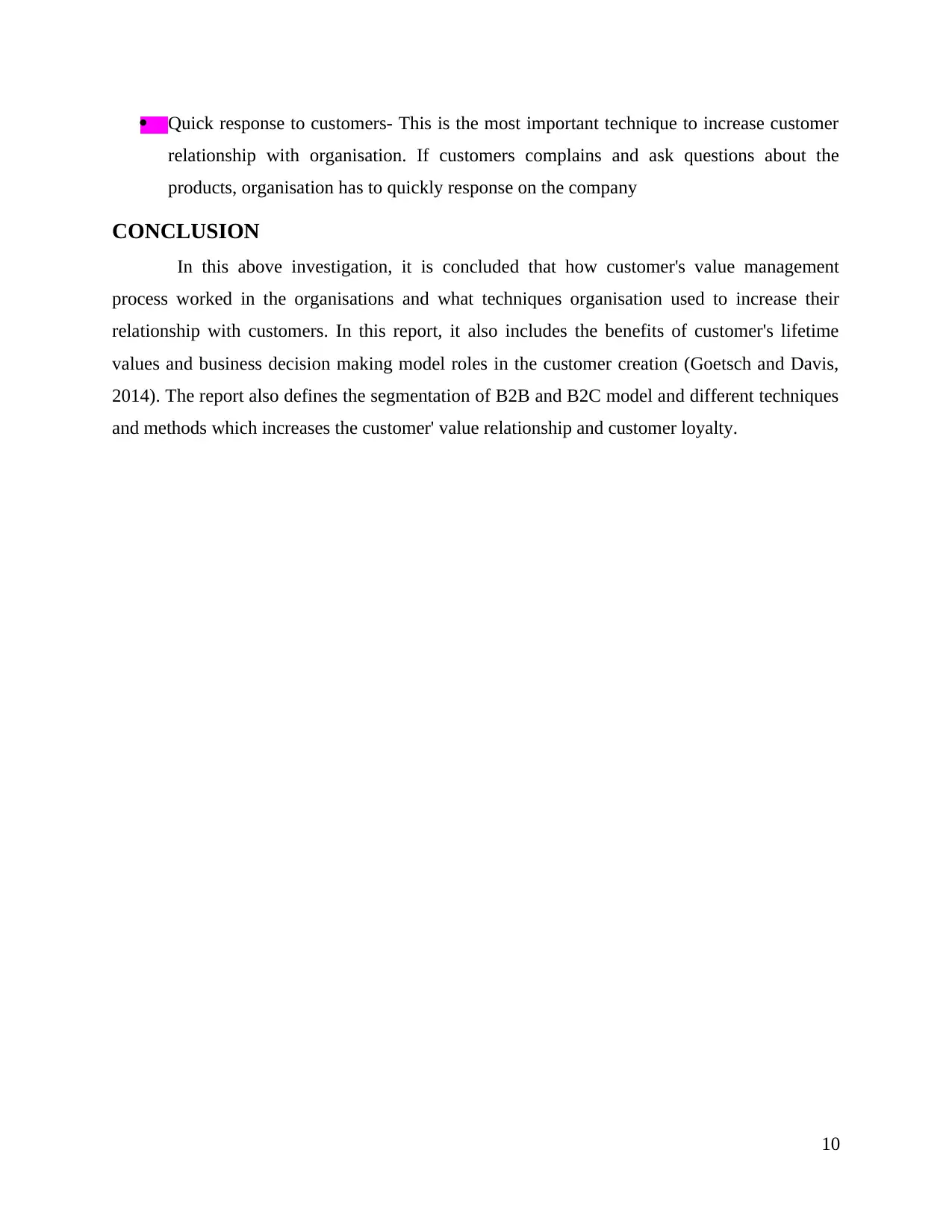
Quick response to customers- This is the most important technique to increase customer
relationship with organisation. If customers complains and ask questions about the
products, organisation has to quickly response on the company
CONCLUSION
In this above investigation, it is concluded that how customer's value management
process worked in the organisations and what techniques organisation used to increase their
relationship with customers. In this report, it also includes the benefits of customer's lifetime
values and business decision making model roles in the customer creation (Goetsch and Davis,
2014). The report also defines the segmentation of B2B and B2C model and different techniques
and methods which increases the customer' value relationship and customer loyalty.
10
relationship with organisation. If customers complains and ask questions about the
products, organisation has to quickly response on the company
CONCLUSION
In this above investigation, it is concluded that how customer's value management
process worked in the organisations and what techniques organisation used to increase their
relationship with customers. In this report, it also includes the benefits of customer's lifetime
values and business decision making model roles in the customer creation (Goetsch and Davis,
2014). The report also defines the segmentation of B2B and B2C model and different techniques
and methods which increases the customer' value relationship and customer loyalty.
10
⊘ This is a preview!⊘
Do you want full access?
Subscribe today to unlock all pages.

Trusted by 1+ million students worldwide
1 out of 13
Related Documents
Your All-in-One AI-Powered Toolkit for Academic Success.
+13062052269
info@desklib.com
Available 24*7 on WhatsApp / Email
![[object Object]](/_next/static/media/star-bottom.7253800d.svg)
Unlock your academic potential
Copyright © 2020–2025 A2Z Services. All Rights Reserved. Developed and managed by ZUCOL.





